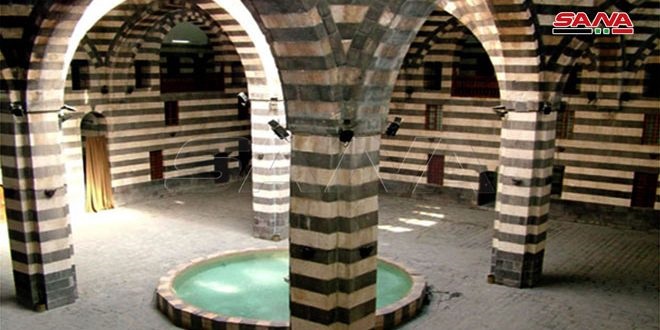Nestled in the Old City in Damascus , Khan Asaad Pasha is one of the most prominent edifices of Islamic architecture, reflecting the city history and civilizations that rose and fell in it across ages..
It is the largest and most noteworthy of the several dozens of khans in the old city of Damascus . The khan is considered one of the most impressive edifices in the orient in regard to its area and its Islamic architectural style.
The marvelous Khan Asaad Pasha was chosen by the Ministry of Culture to host the activity of “ Culture in your Home”.
The khan, which is located to the south of the Umayyad mosque, dates back to nearly 270 years. It was constructed in 1753 on the debris of Umayyad mosque shops and palaces.
At that time , Asa’ad Pasha al-Azem, who served as the Ottoman Governor of Damascus, ordered the building of the khan , which covers 2500 square meters to become as a main center for merchants as Damascus was one of the most important destinations along the silk road. Khan Asaad Pasha was one of the greatest Khans during that era due to its distinguished architectural identity that adopted “Ablaq” style which is an architectural technique involving alternating or fluctuating rows of light and dark stone. This stone is a type of Islamic engineering art that was characterized by architecture in the Levant.
Khan Asaad Pasha was one of the greatest Khans during that era due to its distinguished architectural identity that adopted “Ablaq” style which is an architectural technique involving alternating or fluctuating rows of light and dark stone. This stone is a type of Islamic engineering art that was characterized by architecture in the Levant.
The entry to Khan Asa’ad Pasha is through a six-meter gateway decorated with stone carvings and muqarnas (architectural shape ) on the western side of the building . The layout of the khan is a square plan featuring a sizable central courtyard covered by eight domes. The khan’s main structure is surrounded by a covered courtyard containing a large fountain, stone benches, corinthian, Ionian and Tuscan pillars in additions to arches and domes.
The khan’s main structure is surrounded by a covered courtyard containing a large fountain, stone benches, corinthian, Ionian and Tuscan pillars in additions to arches and domes.
As architectural decoration, the visitor sees columns with a form of braids on either side of the entrance which date back to the Greek era in addition to muqarnas from the Islamic era.
Khan Asaad Pasha al-Azem consists of two floors, the basement includes 40 rooms that are dedicated to store goods while the second story includes 44 rooms which were meant to host people as accommodation.
In 1757, Damascus was exposed to a major earthquake that destroyed most parts of the Khan.
At the beginning of the 19th century, merchants of Al-Bozoriyah market opened and restored it .
In the 80s , the khan was cleared and declared a heritage site, and the Department of Museums and Archeology in Damascus took charge of restoring it.
Khan Asa’ad Pasha currently features art exhibitions and other cultural activities .
Rawaa Ghanam

